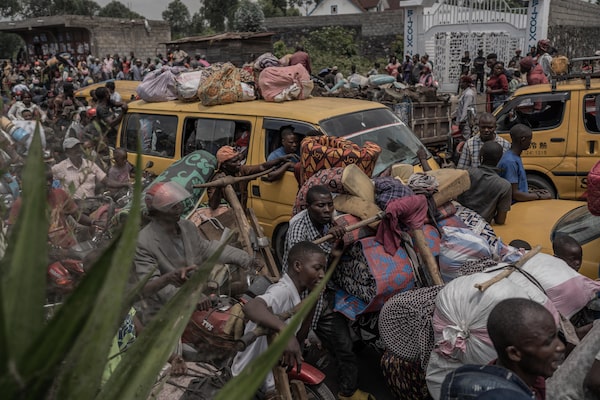
People gather at a busy road while carrying some of their belongings as they flee the Masisi territory following clashes between M23 rebels and government forces, at a road near Sake, Democratic Republic of the Congo, on Feb. 7.AUBIN MUKONI/Getty Images
South Africa has suffered its first fatalities in its military campaign to stabilize eastern Congo, just three days after announcing the deployment of nearly 3,000 soldiers to the war-ravaged region where Rwandan-backed M23 rebels are threatening to capture the provincial capital.
Two of South Africa’s soldiers were killed and three injured when a mortar bomb landed inside one of the bases of its advance reconnaissance team near the North Kivu capital, Goma, according to an army statement on Thursday.
The Democratic Republic of the Congo’s army, poorly paid and equipped, has failed to push back the M23 which began an offensive in 2022. The Congolese government has recruited military help from a number of countries and organizations.
The worsening fighting has caused another escalation of the humanitarian catastrophe in Congo. It has forced about 135,000 people to flee their homes in the past eight days, adding to the 2.5 million people who are already displaced in North Kivu. Many walked to Goma with their belongings on their backs, and hundreds of thousands are now living in tents or makeshift accommodations in poor conditions.
Less than two weeks ago, a South African helicopter was riddled with dozens of bullets near Goma during a medical evacuation flight. Its commander and a medic were injured, but the helicopter was able to land safely.
The Rwandan-backed M23 militia group – the main rebel force in the Goma area – is suspected of perpetrating both the helicopter attack and the mortar bomb, although there is no official confirmation.
In a third incident this month, a surface-to-air missile was fired at a United Nations observation drone in eastern Congo without hitting it. An unpublished UN report identified a Rwandan mobile missile launcher in the territory north of Goma as the source of the attack, according to media reports.
The attacks have drawn attention to the heavy firepower and sophisticated weaponry of M23 – formally the March 23 Movement, and named after an earlier failed peace agreement – and its Rwandan allies. The British-based defence publication, Jane’s, reported that the militia group now has an advanced system of guided long-range mortar rounds in its arsenal, in addition to the surface-to-air missiles.
South African President Cyril Ramaphosa announced on Monday that he has authorized the deployment of 2,900 soldiers in eastern Congo in a 12-month mission with an expected cost of US$105-million. Their advance team of several hundred soldiers arrived in Goma in December. Tanzanian and Malawian troops are also joining the Southern African regional force, which will number about 5,000 soldiers.
Other military campaigns in eastern Congo – including an East African force and a UN peacekeeping mission – have failed to quell the M23 militia group, which has massacred civilians and captured a huge swath of territory. A series of UN reports have documented M23′s role in multiple atrocities against civilians and its close links to the Rwandan military for weaponry and other supplies.
South Africa’s two biggest opposition parties, the Democratic Alliance and the Economic Freedom Fighters, both said this week that South Africa should withdraw its troops from Congo because the mission is too dangerous and the soldiers lack the required equipment to protect themselves, including helicopters or other aircraft to provide cover against enemy fire.
Mr. Ramaphosa, speaking in parliament on Thursday, insisted that the troops have the military hardware that they need.
“We salute our defence force personnel who brave great dangers to make Africa a more peaceful and stable continent,” he said.
M23 has gradually cut off all land routes into Goma, a city of more than two million people, including about 500,000 displaced people. Food prices are rising as fears of shortages intensify.
The rebels are now besieging the town of Sake, the last major town on the road into Goma from the west. They are reportedly on the hills around the town, firing artillery shells that have landed in Sake and on the outskirts of Goma itself, about 25 kilometres away. Two-thirds of Sake’s population has fled, UN agencies say.
The UN refugee agency, UNHCR, said it is deeply alarmed that the shelling has hit sites in Sake and Goma where as many as 65,000 displaced people are sheltering. At least 15 civilians have been killed and 29 injured around the two towns this month.
“The presence of unexploded ordnance poses a particular threat to children,” UNHCR said in a statement on Wednesday.
With more than 150,000 new arrivals in the city, Goma is now suffering from “unbearable overcrowding” and a shortage of clean water, heightening the risk of cholera, according to Emilie Vonck, country director for Mercy Corps, in a statement this week.
Another humanitarian agency, the Norwegian Refugee Council, said the water supply in some camps is just three litres per person daily, compared with a minimum standard of 15 litres.
“The humanitarian response in the region was already on a precarious footing: now it teeters on the brink of collapse,” said Eric Batonon, the group’s country director for Congo, in a statement.
 Geoffrey York
Geoffrey York